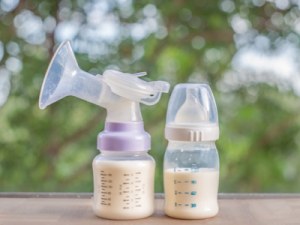In aid of National Breastfeeding Week, here are 10 tips for combined bottle and breastfeeding.

1. If you have problems with low milk supply, or have twins then it can be difficult to meet your baby’s demands. Seek help from a breastfeeding advisor to help get your milk supply up, but as an alternative supplementing your baby’s breastfeeds may be necessary.
Using some formula milk does not mean the end of breastfeeding, it is quite possible to do both and continue to give baby the benefits of your milk.
2. In the early months it is a good idea, and sometimes necessary, to express milk at the same time you are giving your baby a bottle. This is to prevent engorgement and to protect your milk supply.
3. Having all of your feeding equipment ready in advance makes things much easier. Breast pumps, milk storage containers and bottles can all be sterilized in advance, assembled and ready to go for up to 24 hours before being sterilized again for the next use.
4. It is important to correctly sterilize all your baby’s milk feeding equipment to reduce the risk of milk bacteria related tummy bugs or gastroenteritis. Before each use wash all pieces separately using a separate brush, rinse in clean water and sterilize. Steam sterilization is easy and efficient.
5. Your breastmilk can be frozen, which makes having a supply of milk ready to use much easier. Express straight into a breastmilk storage container and once the milk has cooled it can then be frozen and stored for up to three months in your home freezer.
6. Always keep breastmilk chilled until your baby is ready to feed, then warm it to body temperature by using a bottle warmer or standing the container in warm water. Take a small flask of warm water if you are out & about and carry milk in a ThermaBag to keep it cool.
7. Be sure to use the correct teat size for your baby’s needs. If the teat is too slow your baby may become bored or frustrated during his feeds. A teat which is too fast may mean your baby struggles to keep up with the flow of milk, taking in a lot of air as he gulps. The flow should be steady and your baby relaxed during the feed.
8. If your baby is having a bottle feed then it is a lovely opportunity for dad, or another family member to be involved. Of course bonding happens in many ways but feeding is a very nurturing and special way to interact with baby.
9. When bottle feeding, hold your baby close in a more upright position than you might for a breastfeed. Hold the bottle at an angle which keeps the teat full of milk, and your baby’s head in a slightly backward tilt so that he can feed comfortably. He will be looking at you intently as you feed him so enjoy this special nurturing time.
10. When taking a bottle some babies are good at knowing when they need to burp and will push the bottle away with their tongue, or with their hands if they are older! Other babies keep drinking and then are sick so you may need to stop your baby at times during the feed to sit up for a burp.
About the author
This article was developed by Vicki Scott, Midwife and Parenting Expert.








